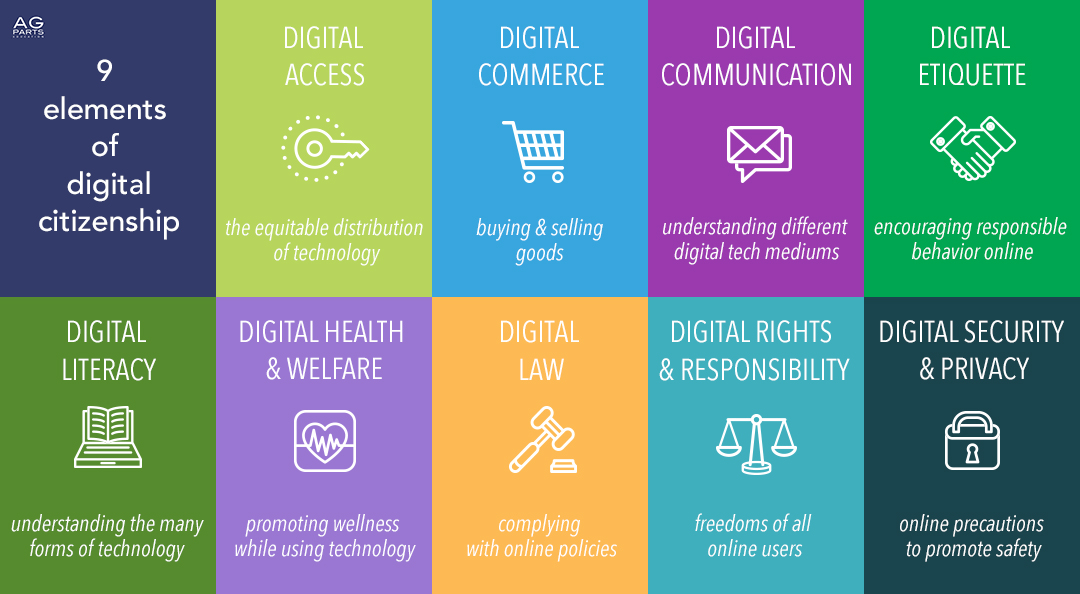More than 175,000 children go online for the first time every day and 1 out of 3 internet users are children. As part of internet safety for students, understanding the 9 elements of digital citizenship has never been more important.
Digital Citizenship & Digital Citizens Defined
Everyone who uses the internet and technology is a digital citizen. Through the use of the internet and technology, digital citizens engage in all aspects of society from politics to ecommerce to connection via social media.
Digital citizenship is engaging responsibly with technology, the internet, and its users. Every digital citizen should endeavor to follow the 9 elements of digital citizenship which lays guidelines for appropriate use.
Why is Digital Citizenship Important?
Only 7% of Americans never go online, with 25% of that small percentage being 65+. Couple this with the fact that 97% of Americans own a cell phone (of those, 85% own a smartphone) and practicing the 9 elements of digital citizenship has never been more important. It’s crucial we all do our part to make the internet the safest and most equitable place possible.
In 2019, 41% of American students had their own device through their school’s 1:1 computing program. While that may seem like a modest percentage, that doesn’t address the schools where one device is available to five or fewer students. Nor does it address the increased demand for 1:1 programs or student devices following 2020.
Children are using technology at home, too. Although most believe that children should have their first smartphone later, the average age for a child to have their first smartphone is 10 years old. By age 8, 42% of US children have their own tablet. As technology and internet use continues to permeate our lives and younger generations, students must learn about digital citizenship at early age to ensure their responsible use of the internet and technology.
9 Elements of Digital Citizenship
There are 9 elements of digital citizenship that every digital citizen should be familiar with. They are:
1. Digital Access is the equitable distribution of technology and not only understanding who has access to technology, but the limitations and consequences to those who have limited access to technology.
2. Digital Commerce is the buying and selling of goods. This principle focuses on making safe and informed decisions when purchasing or downloading materials online.
3. Digital Communication is understanding the different modes and mediums of digital technology and when to appropriately use them. For example, understanding when sending an email is appropriate versus sending a text message.
4. Digital Etiquette is understanding appropriate code of conduct and procedures when using mobile devices. It extends beyond recognizing bad behavior in that it actively encourages appropriate and responsible behavior online.
5. Digital Literary or Fluency is the process of understanding technology, how to use it in its many forms, and how to adapt when new technologies are introduced. It also extends to internet usage and how to effectively search and evaluate information online.
6. Digital Health & Welfare is maintaining sound technological practices to promote physical and psychological wellness. Practicing eye safety and ergonomics, and balancing screen time and technology usage are all related to this important principle.
7. Digital Law is understanding and complying with online rules and policies, and how to use technology ethically. Digital law is broad and covers topics from spam to cyberbullying.
8. Digital Rights & Responsibility are the freedoms that extend to everyone online. Examples of this include right to privacy and free speech.
9. Digital Security & Privacy are electronic precautions to bolster online safety. Secure passwords, not sharing passwords, backing up data, and antivirus protection are all examples of this principle.
Digital Citizenship Resources
As we’ve established, introducing digital citizenship early is key. Equally important is teaching digital citizenship all year, every year. As students age, their online activities will change. What they learn in second grade is not what they will learn in ninth grade, which is why it’s important to teach this subject yearly.
There are many tools available to teach digital citizenship. Check out these helpful resources:
- Common Sense Media offers free courses for all school-aged children
- ITSE U offers a comprehensive digital citizenship course to equip teachers, coaches, and other leaders
- Edutopia shares a complete guide of helpful blogs and videos about digital citizenship
- Cyberwise offers free cyber civics resources for families
AGParts Education supports 6,000+ innovative 1:1 school districts in Chromebook parts supply and technology buyback. Contact us today to see how we can help your school.


Recent Comments